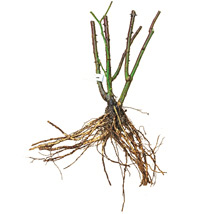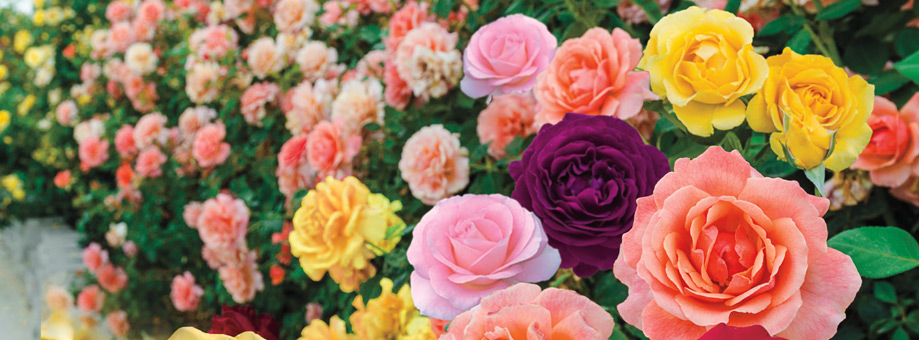- About Bulbs
- Landscaping Tips
- Planting & Care of Bulbs
- Tips for buying Bulbs & Perennials
- Planting & Growing Instructions
- Allium Planting and Growing Tips
- Astilbe Planting and Growing Tips
- Begonias Planting and Growing Tips
- Calla Lily Planting and Growing Tips
- Crocus Planting and Growing Tips
- Daffodil Planting and Growing Tips
- Dahlia Planting and Growing Tips
- Daylily Planting and Growing Tips
- Gladiolus Planting and Growing Tips
- Hosta Planting and Growing Tips
- Hyacinth Planting and Growing Tips
- Iris Planting and Growing Tips
- Lily Planting and Growing Tips
- Peony Planting and Growing Tips
- Rose Planting and Growing Tips
- Tulip Planting and Growing Tips

Selecting a Rose Plant or Rose Bush
Because of the long lifespan of hardy roses, choosing a rose plant can be a major commitment—that rose is likely to decorate your garden for years, or even decades! Luckily, thanks to modern rose hybridization, there's a rose plant for every garden and every purpose.Choose your roses based on climate, sun requirements, support requirements—and, of course, appearance! Climbing or shrub roses lend themselves to the creation of romantic privacy arbors, while upright roses serve well as the backdrop to shorter garden flowers. Consider the space you have to devote to your new rose plant, and the landscape that will surround it. Look not only at height requirements when choosing a rose plant, but width and support requirements as well. Some roses grow "out" more than up!
Planting Roses
You've chosen the rose bust perfect for your yard—now, how do you make your yard perfect for your new rose? Let's talk about the best way to plant roses.How to Plant Roses
- Dig a hole 12-18 inches deep, ensuring that it's wide enough that all of the roots can be spread out without touching the sides of the hole.
- Next, figure out what amendments your soil needs. Roses, like many plants, prefer slightly acidic soil. Luckily, most American soil is in the right range! If you think your soil may be alkaline—in effect, if you have clay soil—choose a sulfur or aluminum sulfate mix to acidify the soil. You'll also want to mix your soil with a good measure of leaf mold, peat moss, manure or compost, to add nutrients and drainage. Remember: roses don't like to have wet feet!
- Unwrap your bare root roses, and trim off any broken roots.
- Mound a cone of soil in the center of the hole, then spread healthy roots around the soil mound with bud union (the knot at the base of the plant) at ground level for mild climates, or two to three inches below ground level for cold climates.
- Fill the hole half full, and then water the roses well to settle the soil and eliminate air pockets.
- Let the water drain, then fill the remainder of the hole with soil mixture. Water thoroughly again.
- Mound loose soil up and around the canes to protect the plant from sudden temperature changes.
- Gently wash away soil to ground level when rose is well-sprouted.
Where to Plant Roses
In order to plant roses, you'll need a little elbow grease and a great location. Most roses prefer at least six to eight hours of sunlight each day, especially morning sun. Adequate sunlight keeps roses from becoming leggy, and keeps them blooming. Shrub roses and climbing roses can typically tolerate a bit more shade. Choose a planting location that will accommodate your roses' need for light, and fit their potential growth—both height-wise and width-wise. You also need to choose a location that drains well: overly wet conditions can cause mildew and fungus for your roses.When is the Best Time to Plant Roses
Roses will get their best start in your garden if you plant them in the spring, after the last frost. Planting early in the year gives your roses' roots enough time to settle in before the plant goes dormant over the winter. Bonus points if you plant your roses on a calm, cloudy day—planting in the rain is no fun and can make setting the rose difficult. If you buy your roses from Breck's, we will ship them to you when they should be planted!How to Take Care of Roses
Thanks to innovative hybridization practices, rose care has never been easier. These plants are bred to grow into healthy, proliferous roses! By following and practicing our rose care tips and tricks and a little continuing care, you should be able to enjoy your hybrid rose plants for years.Watering Roses
When it comes to rose plant care, roses require frequent watering. If your area isn't getting frequent rain, water your roses deeply twice per week. Water them early in the day. By watering in the morning, you're giving your roses several hours to dry out before nighttime dew sets in: continous damp conditions can lead to mildew on your rose leaves and petals.Fertilizing (Feeding) Rose Plants
Can you use the same fertilizer for roses and other plants? Most likely! Roses benefit from a balanced fertilizer, such as a 10-10-10 fertilizer. However, you should dilute the fertilizer to half the strength prescribed on the packaging. Some pre-diluted fertilizers are available, but you can have plenty of success using the diluted version of your favorite flower fertilizer.Protecting Your Roses From Pests or Disease
Modern roses are much more disease resistant than their heirloom relatives. However, they are susceptible to certain types of fungus and pests. If your roses develop "blackspot" or a powdery appearance, use a commercial fungicide on the leaves. Aphids, Japanese beetles, and spider mites are all common rose garden pests. If you find holes in leaves, or webs amongst your canes, use a strong stream of water to blast away bugs, and follow up with an insecticidal soap.How to Prune or Trim Roses
Modern roses should be pruned early in the spring, when about half of the growth buds swell. Because most roses bloom on both "old wood" and new growth, you shouldn't cut your roses entirely down. Instead, cut back about one-third to one-half of the previous year's growth. Remove any damaged wood, or canes that rub together. Trim any suckers from the base of your plant.How to Care for Roses in Winter
If you live in a zone colder than Zone 5, protect your roses from winter cold. After the first "killing frost" of autumn, mound loose soil about eight inches high over the base of your rose plant. Then, pile hay or straw over the remaining exposed canes. Clear the material away after the last frost of the year.When Do Roses Bloom?
Roses bloom throughout the season from mid-spring to fall. Because of their lengthy bloom time, roses are among the most popular and desirable plants to grow.Types of Modern Roses
While roses were once thought of as the high-maintenance divas of the garden, advances in breeding and growing have changed that. Today's roses need relatively little care. We offer rose bush varieties of grandiflora roses, floribunda roses, hybrid tea roses, shrub roses and climbing roses.Grandiflora Roses
Grandiflora roses are a mix between classic hybrid tea roses and more modern Floribunda roses. These roses feature huge, brightly-hued flowers on prickly stems, as well as dark, glossy leaves. Grandifloras are tall—they can grow to a height of nearly five feet—so they work well in the back of the garden. Their long stems make Grandifloras incredible cutting roses! Grandifloras bloom repeatedly throughout the season, and bloom on both old and new wood.Floribunda Roses
Floribunda roses were first introduced by a Danish breeder in 1907. Floribundas are a cross between hybrid tea roses and polyantha, and bring you the best of both worlds: amazing colours and prolific blooms. Floribundas have small, pointed flowers like hybrid teas, but they bloom in multi-flowered sprays, creating a bigger burst of blossoms. If you live in a zone colder than zone 5, your climate may be too cold for some types of roses. Floribunda roses tend to be more cold-hardy, and may be a good choice for northern gardeners.Hybrid Tea Roses
Hybrid teas are the foundation of the modern rose garden! This wide category of flowers were hybridized throughout the late 1800s and popularized due to their perpetual blooming habit. Hybrid tea roses grow pointed, single-petaled flowers that unfurl into classic spiraled blooms. Hybrid tea roses are smaller than Floribundas or Grandifloras, and tend to be the most fragrant variety of roses.Shrub Roses
Are shrub roses "real roses?" You bet. While they aren't as showy as long-stemmed roses, shrub roses offer thick foliage and privacy along with bouquet-worthy blooms. These prolific bloomers offer a full spring and summer of flowers—and shrubbery, too.Climbing Roses
What's more picturesque than climbing roses? Roses that twine their way up an arbor, trellis, wall or pergola make for a scenic backdrop and a unique landscape. Just like upright roses, climbing roses have been bred for disease resistance and ongoing flowering.No matter what rose bush you choose, Breck's promises to bring you healthy rose plants—and get your rose garden off to a great start!
Planting Video for Bareroot Roses










